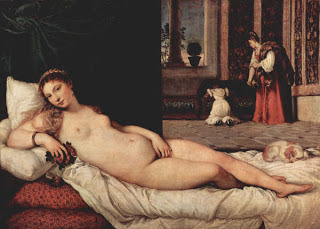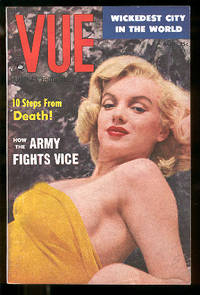ads
The way women were portrayed.
Hans Memling "Vanity" 1485

Idea of looking at her without her looking back. Objectifying women. The women's on display for our viewing pleasure.
Objectifying "Students not individuals." "A blonde not a person." Feminism.
Reciprocity, giving and taking. Unbalanced. Fundamentally about power.
Allowed to look without being looked at. Gaze upon without being gazed upon. She's vain. "She's kind of asking for it"
Men would buy the painting. They'd be using their symbolic power. Patriarchal households.
Consumed by men. Society was patriarchal. Nude became accepted. Mens power over women.
Power domination. Patriarchal ideal of femininity.
Male - Active/Dominant
Controlled means of visual design. Very few female artists in history, still very few now compared to men.
Women objectified and sexualised on display. Culture has made this. As women have never been the symbol of the dominant, bread-winner in culture and society.
"The Birth of Venus" by Cabanel
The Birth of Venus is passive. We're gazing at her, but she's not gazing back and arguably knows she's being gazed upon but doesn't want to look straight back at you and instead is kind of looking away and hiding her face in a shy manner. The male would feel dominant in this situation, or whoever is gazing upon the painting. Fundamentally a fantasy. But made by real people.
"Sage" in culture. Abstract notion of art. Right in the middle of industrialisation, mid 19th century.
Olympic, Manet. 1863
This, unlike the birth of venus shows an active figure. It's kind of not art, but reality. A comment on the gaze relations in the production of at. Challenges the safe notion that women are passive and you can't actually look at them without being challenged by the woman.
Analysing the art you can study the body language of the woman in question and guess she's probably a prostitute, being delivered flowers from suitors. Her head is risen off the pillow and she's clearly acknowledging our gaze and looking directly at us. Her left hand is kind of placed to cover up, rather than invite.
The black cat can also be symbolic of independence.
This is in contrast to Titian's Venus of Urbino, 1538
The woman in questions body language here is much more inviting than Manet's. Acknowledging our presence but also kind of inviting. Manet's painting may be a comment on Titian's painting, some 300 years later. Her head and general body posture is very laid back and comfortable, kind of seductive. She looks like she's got all dressed, done her hair for this painting. her left hand isn't really covering up but kind of inviting you.
In this case, similar to Manet's piece there are animals in the picture, but a dog instead of a black cat. A dog can symbolise being a master, almost as if this is a scene you could come home to after a long day at work bread-making. The women is again, given the status of being at home, making herself an object of desire for the male again. Objectified.
Vue America's Photo Digest
Women being objects of desire and basically the idea of sex sells. But the idea of sex sells only seems to be purveyed through women. Not men, especially in the past, maybe not as much now.
"My Hobby is Men" sexual tittilation. She's asking for it, women just want sex and men will give it to them.
There are hundreds of magazines out there even now such as this where the main topics are about how to please men and how to attract men. Kind of the idea of women running around trying to please men, while men don't worry about it and do manly stuff like make money and feed families.
"Cure for frigidity" - if someone doesn't want to have sex with you then she's just mad, she's crazy. Get her cured.
Women used to be painted and captured with kind of child-like faces. I guess this can be another way to feel superior over women and in a way make them look pure and a bit like a virgin, perhaps. Which is historically an appealing way of objectifying women as objects of desire.
e.g. Katie Price is an object of desire and an overly sexualised pop culture icon. At the same time as being appreciated, she's also at the same time a butt of many jokes and a symbol of the negative side of todays culture of excess. Kind of like the media supports you and feeds you and at the same time mocks you and takes away from you to keep you where they want you to be. Supporting and punishing at the same time.
The Sun Page 3 girls - Einstein Quote gags. Almost implying that it's funny because these naked models couldn't possibly be clever enough to know Einstein quotes.
Her body language is quite dominant, cocky and assertive. The roles are reversed here in terms of the gaze. She's challenging our gaze and challenging the perceptions that may be had regarding cooking. This is aimed at both men and women. Sexually appealing to men and giving girls independence and confidence in terms of appealing to men. Again, the idea of appealing to men. A bra which is an object with a function has been sexualised in order to appeal to men and probably the main reason women buy certain underwear.
Bond girls - objects of desire and sex appeal and have very little value in terms of making a stamp on the plot. Often just discarded and in very few scenes.
Legacy of Image Making - Women's magazines, more concerned with what men want, whereas mens mags just have girls as objects. For example Nuts compared to something like hello, both of which target roughly the same age group but in opposite sexes.
Aimed at guys.
Aimed at women.











No comments:
Post a Comment